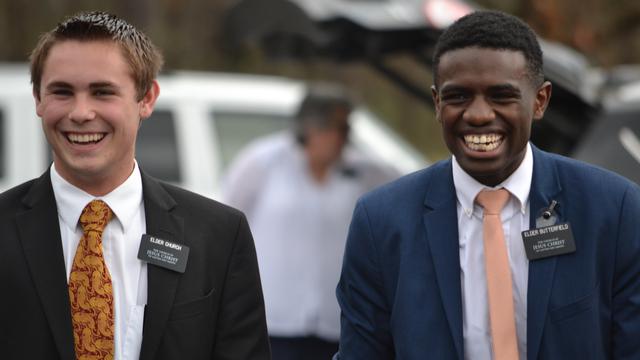
Missionaries of the Church of Jesus Christ of Latter-day Saints, 2017. On Friday the church announced that in addition to the traditional mission as seen here, some young adults will be called to new “service missions.” Photo courtesy of Intellectual Reserve, Inc. All rights reserved.
Service missions, shorter terms of service, and the opportunity to still live at home. These are the main changes that will affect some missionaries of the Church of Jesus Christ of Latter-day Saints, starting in January 2019, the church announced Friday.
The key word there is “some.” The church is still prioritizing the “proselyting” mission, which a majority of Mormon missionaries will apparently continue to serve. In that more traditional scenario, missionaries don’t know where in the world they’ll be sent, only that their service will last either 18 months (for young women) or two years (for young men).
Service missionaries, by contrast, may be assigned as little as six months as they work in charitable organizations and “church operations” in their local areas. They will continue to live at home under the care of their parents, while their local stake president, rather than the area’s mission president, is responsible for supervising them. Friday’s Mormon Newsroom announcement gave several examples of service missionaries who have participated in trial programs of this nature.
Readers of this column may remember that this kind of service mission was one of the rumored predictions at last month’s General Conference. It didn’t become reality at Conference, but weeks later here it is: one of the most interesting and potentially expansive changes to the missionary program in a generation.
In general, I’m pleased with the policy’s recognition that a full-time proselyting mission is not for every young person. The 24/7 life of a Mormon missionary can be exceptionally stressful, especially in a culture that emphasizes exacting obedience. An article earlier this week in the Deseret News—foreshadowing, apparently—explored the anxiety experienced by many missionaries, some of whom are sent home early.
The service mission has the potential to include many young adults who would otherwise be shut out of the opportunity, including those with disabilities. I think they and their families will be excited and grateful. So that’s a win.
I’m also thrilled, always, to see Mormons get out of our own silos and involved with our communities in efforts that benefit life for everyone. Emphasizing humanitarian service is a real step forward.
My concern is that even though the First Presidency’s letter emphasizes that a service mission is “an acceptable offering to the Lord” and should not be referred to as inferior to a proselyting mission, the way the church has set up the system of who serves what kind of mission actually undermines this goal.
All prospective missionaries will apply online, and follow the usual protocol of being interviewed by their local religious leaders to determine their worthiness. They will also participate in medical evaluations to gauge their health. But that’s where the similarity ends:
During the recommendation process, all candidates will be considered first for full-time proselyting missions. Those unable to be called as proselyting missionaries for physical, mental or emotional reasons may be called as service missionaries. In some cases, candidates will be honorably excused from any formal missionary service.
In other words, there will be a three-tiered system: those who are fit to serve proselyting missions, those who are not but can fulfill service missions, and those who cannot serve at all.
This is not what I was expecting to happen. Early rumors had emphasized choice—that some perfectly healthy people might choose to go on service missions because they had a heart for working in the community rather than for the traditional method of preaching the gospel to strangers. And that they would be serving together alongside people with disabilities, so that the service mission would not be stigmatized.
The new policy not only precludes individual choice but risks creating a class system, a lower tier of people with physical, mental, or emotional disadvantages. It provides them with an opportunity to serve, which is lovely, but it also ghettoizes them with other young adults who didn’t make the cut.
Related posts:
- Top 5 Mormon rumors about General Conference
- I hope they call you on a Mormon mission
- Are Mormon missionaries being denied health care? How Slate dropped the ball






